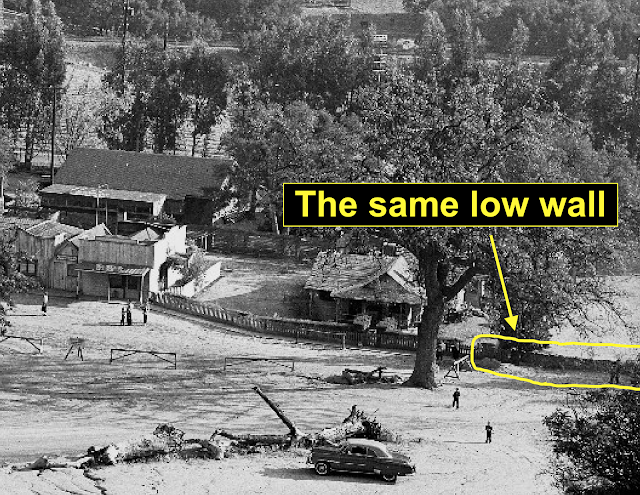Another one bites the dust (photo by Cliff Roberts)
Grim news in the southeast corner of Simi Valley, Calif., as the tall oak tree that presided for decades over Corriganville's Silvertown has succumbed to the ravages of time, old age and drought.
Location researcher Cliff Roberts came upon the wreckage of the tree on a hike through what is now the Corriganville Park.
Corriganville's Silvertown, circa early 1950s
The tree stood tall at the west end of Silvertown, Corriganville's famed Western town set. In this wide view of the town, the tree can be seen all the way at the right. (You may want to click on the photo to see a larger version.)
The tree is highlighted in this version of the Silvertown overview. In addition to being a busy filming location, Corriganville was a popular theme park in the late 1950s and 1960s.
Zooming in on the section at the far right of the previous photo, we get a better look at the southwest corner of Silvertown, where the tree stood in front of Corriganville founder Ray "Crash" Corrigan's house.
The house and tree both appeared in productions filmed at Corriganville.
"Six-Gun Serenade" (Monogram, 1947)
This shot from the Jimmy Wakely B-Western "Six-Gun Serenade" shows the tall oak tree in 1947, at the right, along with the picket fence in front of Ray Corrigan's house, at the left.
A shot from the Wayne Morris B-Western "The Fighting Lawman" shows a little bit of the southwest corner of Silvertown, where Ray Corrigan's house, with its distinctive picket fence, marked the end of the street.
From this angle the tall oak tree is mostly hidden.
A cluster of rocks can also be seen at the end of the street.
The same rocks in 2017 — previously seen at the west end of Silvertown
These rocks can be matched up with the rocks in the old movie photos. Notice the rocks labeled A, B and C.
"The Fighting Lawman" (zoomed in)
The same rocks — A, B and C — are identified in the shot from "The Fighting Lawman." I've zoomed in on the movie shot here to make it easier to see the individual rocks.
A section of the same wall can be seen in the photo from the 1950s.
Ray Corrigan's low stone wall in 2017 (photo by Cliff Roberts)
Here's another section of the wall as it appears in modern times, essentially lying in decay. I assume other film historians are aware of the wall, but I've never seen anything documented about it.
Corriganville's mighty oak tree in 2009, already in bad shape. (Photo by Jerry England)
The tall oak tree struggled for years to survive the region's historic drought. In an ironic twist, when the end finally came it was immediately on the heels of one of Southern California's wettest winters in history.
The tree was apparently just waiting for the right time to keel over, and that time arrived in the spring of 2017. The wet winter probably expedited the process by softening the ground around the tree.
The tree's tortured limbs provide a testament to the force of the crash.
The crash left a morass of twisted timber strewn across a wide swath.
I was lucky enough to visit Corriganville a couple of times when I was a kid, and it was an amazing place. I've blogged about it before, and you can check out a few of those posts here, here and here.
Off the Beaten Path is a series of posts that stray from the usual subject matter of this blog, which is the Iverson Movie Ranch. Past subjects have included Franklin Canyon, Bell Ranch, Pioneertown, Corriganville, Oak Park and other old filming locations. You can go directly to the Off the Beaten Path posts by looking up the term "Off the Beaten Path" in the long index of labels at the right of the page, or by clicking here.
























6 comments:
Always enjoy your posts!
Thanks again for a great blog entry. It's sad to see the tree's demise. It was a fine landmark for identifying old locations.
Thanks for letting me work with you, it's always a pleasure.
Bravo great work, I live for your blog posts. So much history here…..thank you so much.
Very well done! I still don't see a place that says "Post your Comments" I got in here by clicking on previous comments. Thanks for all you do! Have a great presentation!
I was saddened to see the tree fallen down on a hike a few years back. A real shame. Another shame is the tree next to Outlaw Boulder that burned due to the big fire in 2018 (I think). Roy Rogers was in that tree in 1940s The Carson City Kid.
Post a Comment